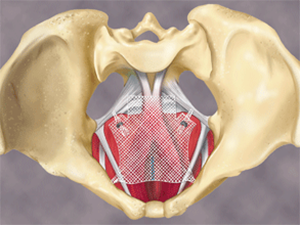A change in the position of the uterus relative to its normal location is not always treated conservatively. And to return the organ to the previous state is necessary, because neighboring areas suffer from its displacement, pains occur, and other health threats up to lethality. The plasticity of the cervix during omission, as well as other ways of surgical intervention, will help to solve the problem.
Objectives of surgical treatment of
 Over time, due to frequent births, gynecological diseases, severe physical exertion of pelvic floor muscles and ligament,supporting the genital and urinary organs, weaken. The tissues are stretched, as a result, the cervix can end up in the vagina. Prolapse sometimes and doctors diagnose when to correct position it is possible only surgical method.
Over time, due to frequent births, gynecological diseases, severe physical exertion of pelvic floor muscles and ligament,supporting the genital and urinary organs, weaken. The tissues are stretched, as a result, the cervix can end up in the vagina. Prolapse sometimes and doctors diagnose when to correct position it is possible only surgical method.
The operation when the cervix is lowered is assigned depending on the stage of development of prolapse, the age of the woman, her plans for sexual life and pregnancy. There are several ways to conduct them, aiming:
- Restore the position of the uterus;
- Replace adjacent organs;
- Normalize the functions of the reproductive and urinary systems, as well as the intestines.

But prolapse also happens in young women who do not want to give up maternity and sex. For them, the operation should be a restorative, and not stop the functioning of the reproductive system. But there are also possible variants of it.
Regardless of the choice of operating procedure, intervention is performed in the mid-menstrual cycle and after exclusion of the presence of inflammation or infection in the reproductive organs.
The use of a mesh in laparoscopic operation
 Uterine plastics when lowered are carried out using an endoscopic prosthesis that looks like a grid of biocompatible material. The organ does not normally have a monolithic attachment. It is supported by ligaments and muscles, the weakening of which leads to the sagging and prolapse of the cervix in the vagina.
Uterine plastics when lowered are carried out using an endoscopic prosthesis that looks like a grid of biocompatible material. The organ does not normally have a monolithic attachment. It is supported by ligaments and muscles, the weakening of which leads to the sagging and prolapse of the cervix in the vagina.
The grid serves not as an obstacle on the organ's way to aspiration down the axis, but is fixed so that, together with the fasciaes, fix it in place. It joins with sacro-uterine ligaments to the sacrum. In fact, the grid is a prosthesis similar to it.
The operation is done, although under general anesthesia, but laparoscopically. This allows you to reduce the recovery time to 1 month, making it the least uncomfortable for the patient. The entire rehabilitation period, she can not wear weight, play sports. Sex life is excluded for the same period.
The advantages of this operation are:
- Low-invasiveness, in which traumatization of tissues is minimal;
- Physiological, as the material of the endoprosthesis perfectly matches with living tissues;
- Reliability, revealed by the practice of using the grid. Recurrence of the disease is almost not found.
An obstacle to laparoscopic surgery with the use of an endoprosthesis can be an inflammatory process in the pelvic area. In some, the material from which the device is made can cause rejection by the body and rejection.
Shortening of the ligaments
 The plastic of the moved cervix of the uterus during descent may consist in the work of a surgeon with a cruciform ligament supporting the organ. It is performed laparotomically and is combined with vaginal correction.
The plastic of the moved cervix of the uterus during descent may consist in the work of a surgeon with a cruciform ligament supporting the organ. It is performed laparotomically and is combined with vaginal correction.
In the course of the operation, a hole is formed in a wide bundle and passed through it, leading to the back surface of the uterus, a round ligament. Do the same on the other side. Then fix the left circular ligament with the right sacroiliac with the use of synthetic threads. The same is done on the opposite side. The shortened ligaments are fixed on the back wall of the uterus. Then sacro-uterine fix with each other two or three sutures.
This type of plastic in gynecology with the omission of the uterus is shown to young women, as it allows to preserve genital possibilities. But the lack of additional supporting materials makes relapse of the disease more likely. Ligament fibers do not lose the ability to stretch.

With an elongated neck
Plasticity increased in the size of the cervix during omission is in fact a removal of excess tissue, but not only. The optimal type of intervention is the Manchester operation.
It is performed with cuts of the anterior wall of the vagina to gain access to the cervix. The latter is partially amputated, the size of the removed site depends on the degree of elongation( abnormal elongation).The organ is given a conical or wedge shape.
Simultaneously with the amputation of the cervix, dissection of the cardinal ligaments at its base is made, they are bandaged and attached slightly above the level of the operated organ part on the front wall. The remaining fibers are stretched and fixed with each other. Typically, this intervention includes and suturing the walls of the vagina.
The recurrence of organ failure after Manchester surgery is rare. But it significantly reduces the chances of pregnancy, and if the conception, despite the distortion of the shape of the cervix, has come, the woman will have to do a cesarean section.
Surgical strengthening of the pelvic floor muscles
 Those diagnosed with mild uterine lumbar puncture, levatoroplasty in combination with colporphy, may work best. The intervention is aimed at strengthening the muscles of the pelvic floor, that is, it will help when they have retained sufficient tonus.
Those diagnosed with mild uterine lumbar puncture, levatoroplasty in combination with colporphy, may work best. The intervention is aimed at strengthening the muscles of the pelvic floor, that is, it will help when they have retained sufficient tonus.
The operation is the connection of the beams supporting the reproductive organs of the muscles by means of seams. For this, a layered dissection of the back wall of the vagina and a small crotch is necessary. At the end of the operation, they are also sewn up.
Sometimes these interventions supplement the ventrophy of the uterus, that is, its attachment to the anterior wall of the abdominal cavity. It is performed by both laparotomic and laparoscopic methods.
But in this case the reproductive function suffers, as the development of pregnancy is hampered by a decrease in organ mobility, a high probability of inferiority of the placenta.
In each case of the diagnosis of "omission of the uterus" treatment, the operation is appointed by a specialist. It is not worth resisting if it first requires the woman to apply efforts in the form of regular exercises to strengthen the muscles, changing the diet, without directing them directly to the surgeon. And to refuse surgery, if the doctor considers it necessary, also should not. Despite their imperfection, the desired result is achieved in most cases if the woman does not spoil his own way of life.

 We recommend to read an article about the use of the gynecological ring when the uterus descends. You will learn what it is, how and for what the pessary is used, what are the pros and cons of using the uterine ring.
We recommend to read an article about the use of the gynecological ring when the uterus descends. You will learn what it is, how and for what the pessary is used, what are the pros and cons of using the uterine ring.